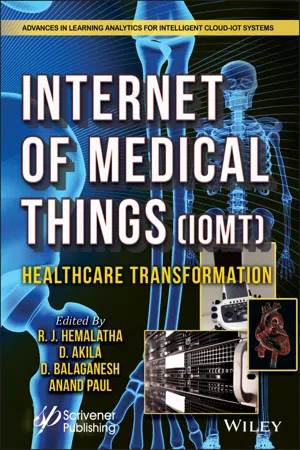
The Internet of Medical Things (IoMT)
Healthcare Transformation
- English
- ePUB (mobile friendly)
- Available on iOS & Android
The Internet of Medical Things (IoMT)
Healthcare Transformation
About This Book
INTERNET OF MEDICAL THINGS (IOMT)
Providing an essential addition to the reference material available in the field of IoMT, this timely publication covers a range of applied research on healthcare, biomedical data mining, and the security and privacy of health records.
With their ability to collect, analyze and transmit health data, IoMT tools are rapidly changing healthcare delivery. For patients and clinicians, these applications are playing a central part in tracking and preventing chronic illnesses — and they are poised to evolve the future of care.
In this book, the authors explore the potential applications of a wave of sensor-based tools—including wearables and stand-alone devices for remote patient monitoring—and the marriage of internet-connected medical devices with patient information that ultimately sets the IoMT ecosystem apart.
This book demonstrates the connectivity between medical devices and sensors is streamlining clinical workflow management and leading to an overall improvement in patient care, both inside care facilities and in remote locations.
Frequently asked questions
Information
1
In Silico Molecular Modeling and Docking Analysis in Lung Cancer Cell Proteins
AbstractIn this study, the three-dimensional (3D) models of lung cancer cell line proteins [epidermal growth factor (EGFR), K-ras oncogene protein, and tumor suppressor (TP53)] were generated and their binding affinities with curcumin, ellagic acid, and quercetin through local docking were assessed. Firstly, Swiss model was used to build lung cancer cell line proteins and then visualized by the PyMol software. Next, ExPASy ProtParam Proteomics server was used to evaluate the physical and chemical parameters of the protein structures. Furthermore, the protein models were validated using PROCHECK, ProQ, ERRAT, and Verify3D programs. Lastly, the protein models were docked with curcumin, ellagic acid, and quercetin by using BSP-Slim server. All three protein models were adequate and in exceptional standard. The curcumin showed binding energy with EGFR, K-ras oncogene protein, and TP53 at 5.320, 2.730, and 1.633, kcal/mol, respectively. Besides that, the ellagic acid showed binding energy of EGFR, K-ras oncogene protein, and TP53 at –2.892, 0.921, and 0.054 kcal/mol, respectively. Moreover, the quercetin showed binding energy of EGFR, K-ras oncogene protein, and TP53 at –1.249, –1.154, and –0.809 kcal/mol, respectively. The EGFR had the strongest bond with ellagic acid while K-ras oncogene protein and TP53 had the strongest interaction with quercetin. In order to identify the appropriate function, all these potential drug candidates can be further assessed through laboratory experiments.Keywords: EGFR, K-ras, TP53, curcumin, ellagic acid, quercetin, docking
1.1 Introduction
Table of contents
- Cover
- Table of Contents
- Title Page
- Copyright
- Preface
- 1 In Silico Molecular Modeling and Docking Analysis in Lung Cancer Cell Proteins
- 2 Medical Data Classification in Cloud Computing Using Soft Computing With Voting Classifier: A Review
- 3 Research Challenges in Pre-Copy Virtual Machine Migration in Cloud Environment
- 4 Estimation and Analysis of Prediction Rate of Pre-Trained Deep Learning Network in Classification of Brain Tumor MRI Images
- 5 An Intelligent Healthcare Monitoring System for Coma Patients
- 6 Deep Learning Interpretation of Biomedical Data
- 7 Evolution of Electronic Health Records
- 8 Architecture of IoMT in Healthcare
- 9 Performance Assessment of IoMT Services and Protocols
- 10 Performance Evaluation of Wearable IoT-Enabled Mesh Network for Rural Health Monitoring
- 11 Management of Diabetes Mellitus (DM) for Children and Adults Based on Internet of Things (IoT)
- 12 Wearable Health Monitoring Systems Using IoMT
- 13 Future of Healthcare: Biomedical Big Data Analysis and IoMT
- 14 Medical Data Security Using Blockchain With Soft Computing Techniques: A Review
- 15 Electronic Health Records: A Transitional View
- Index
- End User License Agreement